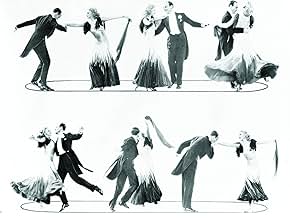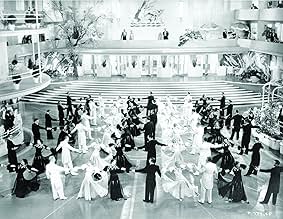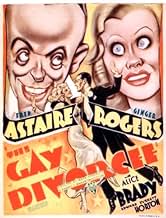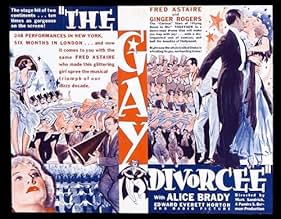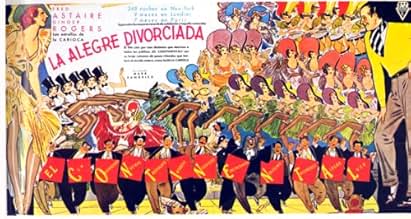CALIFICACIÓN DE IMDb
7.3/10
9.1 k
TU CALIFICACIÓN
Una mujer piensa que un hombre es el corresponsal que su abogado ha contratado para acelerar su divorcio.Una mujer piensa que un hombre es el corresponsal que su abogado ha contratado para acelerar su divorcio.Una mujer piensa que un hombre es el corresponsal que su abogado ha contratado para acelerar su divorcio.
- Dirección
- Guionistas
- Elenco
- Ganó 1 premio Óscar
- 4 premios ganados y 5 nominaciones en total
Norman Ainsley
- Undetermined Role
- (sin créditos)
Jimmy Aubrey
- Undetermined Role
- (sin créditos)
Finis Barton
- Undetermined Role
- (sin créditos)
Eleanor Bayley
- Dancer
- (sin créditos)
De Don Blunier
- Chorus Girl
- (sin créditos)
Pokey Champion
- Dancer
- (sin créditos)
Jack Chefe
- Night Club Patron
- (sin créditos)
Opiniones destacadas
After hearing Fred Astaire put his stamp in a song, it's hard to imagine anyone else attempting to improve in what seems to be the definite rendition of it. That is the case when Mr. Astaire sings Cole Porter's elegant "Night and Day". In pairing Ginger Rogers with Mr. Astaire, Hollywood hit the jackpot as it produced a winning combination that went from film to film with such ease and panache, it will never be imitated.
Mark Sandrich worked with Ms. Rogers and Mr. Astaire in several movies. Somehow, "The Gay Divorcée" is one of their best collaboration. This film is a lot of fun to watch, even after more than 70 years after it was made. It speaks volumes for all the people involved in the production of this movie.
The Great Depression was the right background when movies like this were made. In a way, it was an escape from the harsh realities of the times America was going through. The public went to the movies to see their favorite stars that were shown in such a glamorous roles. How could anyone not admire the great Fred Astaire, always impeccably dressed? Or how could not any woman in the theater envy Ms. Rogers's beauty and easy grace? That era made it right for Hollywood to show the world a sensitivity and sophistication that only few rich types were able to enjoy in real life, while the rest was trying to eke out a life of whatever work they could find.
The musical numbers are amazing. "The Continental" alone, must have blown the budget of the picture. Imagine how much it would cost today to have all those dancers in a sound stage! Not only that, but in that lengthy number, there are at least four changes of costumes for the women. Also, he is delightful singing "Looking for a Needle in a Haystack". A young and radiant Betty Grable makes an appearance singing "Let's K-knock K-knees" in which she shows a bit of her enormous charm and talent.
Ginger Rogers makes a gorgeous Mimmi Glassop. Alice Brady, is perfect as the dizzy Aunt Hortense. Edward Everett Horton plays an excellent Egbert Fitzgerald, the divorce lawyer. Erik Rhodes is one of the best things in the film; his Signor Tonetti injects a funny shot into the movie. Eric Blore, as the waiter, has great moments in the movie.
In setting the film in London and Brighton, a rich texture is added to this winning picture that will remain a favorite that will live forever because of the chemistry that Ginger Rogers and Fred Astaire produced in anything they did together.
Mark Sandrich worked with Ms. Rogers and Mr. Astaire in several movies. Somehow, "The Gay Divorcée" is one of their best collaboration. This film is a lot of fun to watch, even after more than 70 years after it was made. It speaks volumes for all the people involved in the production of this movie.
The Great Depression was the right background when movies like this were made. In a way, it was an escape from the harsh realities of the times America was going through. The public went to the movies to see their favorite stars that were shown in such a glamorous roles. How could anyone not admire the great Fred Astaire, always impeccably dressed? Or how could not any woman in the theater envy Ms. Rogers's beauty and easy grace? That era made it right for Hollywood to show the world a sensitivity and sophistication that only few rich types were able to enjoy in real life, while the rest was trying to eke out a life of whatever work they could find.
The musical numbers are amazing. "The Continental" alone, must have blown the budget of the picture. Imagine how much it would cost today to have all those dancers in a sound stage! Not only that, but in that lengthy number, there are at least four changes of costumes for the women. Also, he is delightful singing "Looking for a Needle in a Haystack". A young and radiant Betty Grable makes an appearance singing "Let's K-knock K-knees" in which she shows a bit of her enormous charm and talent.
Ginger Rogers makes a gorgeous Mimmi Glassop. Alice Brady, is perfect as the dizzy Aunt Hortense. Edward Everett Horton plays an excellent Egbert Fitzgerald, the divorce lawyer. Erik Rhodes is one of the best things in the film; his Signor Tonetti injects a funny shot into the movie. Eric Blore, as the waiter, has great moments in the movie.
In setting the film in London and Brighton, a rich texture is added to this winning picture that will remain a favorite that will live forever because of the chemistry that Ginger Rogers and Fred Astaire produced in anything they did together.
Fred and Ginger, two perfect partners, two of the best dancers in history. In 1934, the toast of RKO. What a great pair the studio that would become defunct in a matter of years had on their hands!
In 1933, the pair had proven themselves as second leads in "Flying Down to Rio", a musical heavily relying on special effects and little else. They stole the show, proven with "The Carioca", the erotically charged dance number which started an American craze of pressing foreheads and even got the Best Song Oscar nod over the supposed show stopping title song. Before, Ginger had "42nd Street" to her name, while Fred had the famous screen test analysis of "Can't sing. Can't act. Can dance a little."
"The Gay Divorcee" is the establishing musical of Astaire and Rogers. Silly, dated, slight, even stupid to a certain degree is the entire story. Without a doubt, high comedy and immense creativity make up for it. The mistaken identity plot was recycled for "Top Hat" the following year, but it hardly matters. It is littered entirely with hilarity! Writing was never the strongest point of these musicals anyway. The performances were not Oscar calibre but they were publicly loved, and it's obviously Astaire and Roger's singing, acting and most of all, dancing, that makes the movie what it is.
A top wealth of talent was assembled for the movie. Erik Rhodes is absolutely side splitting as the Italian guy Tonetti, wielding the fabulous line, "Your wife is safe with Tonetti, he prefers spaghetti!". Alice Brady is there as Aunt Hortense, but Edward Everett Horton is another stand out performer as the lawyer. His fumbling voice provides a character of clumsiness and two seem to go hand in hand. He was definitely one of the best supporting comedians of the 1930s and 1940s, in other Astaire and Rogers musicals, and movies like "Lost Horizon", "Holiday", "Here Comes Mr Jordan" and "Arsenic and Old Lace".
Only one song was retained for the filmic version of "The Gay Divorcee". The censors even crashed down on the stage's original title "The Gay Divorce". Fred performs a great rendition of the immortal Cole Porter song "Night and Day". "The Continental", the Best Song of 1934 is thrown there in the mix too. Other great numbers in there include "Looking for a needle in a haystack", "Don't Let it Bother You" and "Let's K-nock- K-nees". The latter is performed by a young Betty Grable. This is notable for the only time Edward Everett Horton sings and dances on screen. We can see from the results there's an obvious reason.
The stylish period of courtship and even set decoration and costumes evoke great memories of eras gone by. RKO hasn't helped preservation of these technical elements by throwing what always appears to be mediocre sets, but it doesn't matter anyway. The whole thing is irresistible, spectacular and unforgettable. This is one of the forgotten musicals of the time which has it all.
Rating: 8/10
In 1933, the pair had proven themselves as second leads in "Flying Down to Rio", a musical heavily relying on special effects and little else. They stole the show, proven with "The Carioca", the erotically charged dance number which started an American craze of pressing foreheads and even got the Best Song Oscar nod over the supposed show stopping title song. Before, Ginger had "42nd Street" to her name, while Fred had the famous screen test analysis of "Can't sing. Can't act. Can dance a little."
"The Gay Divorcee" is the establishing musical of Astaire and Rogers. Silly, dated, slight, even stupid to a certain degree is the entire story. Without a doubt, high comedy and immense creativity make up for it. The mistaken identity plot was recycled for "Top Hat" the following year, but it hardly matters. It is littered entirely with hilarity! Writing was never the strongest point of these musicals anyway. The performances were not Oscar calibre but they were publicly loved, and it's obviously Astaire and Roger's singing, acting and most of all, dancing, that makes the movie what it is.
A top wealth of talent was assembled for the movie. Erik Rhodes is absolutely side splitting as the Italian guy Tonetti, wielding the fabulous line, "Your wife is safe with Tonetti, he prefers spaghetti!". Alice Brady is there as Aunt Hortense, but Edward Everett Horton is another stand out performer as the lawyer. His fumbling voice provides a character of clumsiness and two seem to go hand in hand. He was definitely one of the best supporting comedians of the 1930s and 1940s, in other Astaire and Rogers musicals, and movies like "Lost Horizon", "Holiday", "Here Comes Mr Jordan" and "Arsenic and Old Lace".
Only one song was retained for the filmic version of "The Gay Divorcee". The censors even crashed down on the stage's original title "The Gay Divorce". Fred performs a great rendition of the immortal Cole Porter song "Night and Day". "The Continental", the Best Song of 1934 is thrown there in the mix too. Other great numbers in there include "Looking for a needle in a haystack", "Don't Let it Bother You" and "Let's K-nock- K-nees". The latter is performed by a young Betty Grable. This is notable for the only time Edward Everett Horton sings and dances on screen. We can see from the results there's an obvious reason.
The stylish period of courtship and even set decoration and costumes evoke great memories of eras gone by. RKO hasn't helped preservation of these technical elements by throwing what always appears to be mediocre sets, but it doesn't matter anyway. The whole thing is irresistible, spectacular and unforgettable. This is one of the forgotten musicals of the time which has it all.
Rating: 8/10
Looking at THE GAY DIVORCEE through the lens of 85 years, I can see flaws with it. The big dance number goes on too long, and the comedy writing isn't sharp enough. Still, this was the first star pairing of Fred Astaire and Ginger Rogers, and it's amazing how much they got right, right off the bat. There's the basic structure of Astaire courting Miss Rogers through a set of dances, while in between there are jokes and pulled faces and Edward Everett Horton doing several hundred double takes per minute as everyone's straight man.
It's based on Astaire's stage success The Gay Divorce. The name change was the result of the Breen office meddling. It's more a variation on the Princess Theater musical comedies of the 1920s, and the camerawork, although seemingly startling and original under the direction of David Abel, is more an outgrowth of German Expressionist camerawork, and bits and bobs from the best of contemporary British musicals. Add in Astaire's insistence on being seen full length while dancing -- which sounds obvious now, although not at the time -- and the formula required only a bit of refinement to produce a series of masterpieces.
You may notice Betty Grable at the bottom of the title card. She's the platinum blonde who makes love to Horton in the "Let's Knock Knees" number. She had been kicking around Hollywood since 1929, sometimes with a credit, sometimes, like her previous movie, without. She would never go uncredited again.
It's based on Astaire's stage success The Gay Divorce. The name change was the result of the Breen office meddling. It's more a variation on the Princess Theater musical comedies of the 1920s, and the camerawork, although seemingly startling and original under the direction of David Abel, is more an outgrowth of German Expressionist camerawork, and bits and bobs from the best of contemporary British musicals. Add in Astaire's insistence on being seen full length while dancing -- which sounds obvious now, although not at the time -- and the formula required only a bit of refinement to produce a series of masterpieces.
You may notice Betty Grable at the bottom of the title card. She's the platinum blonde who makes love to Horton in the "Let's Knock Knees" number. She had been kicking around Hollywood since 1929, sometimes with a credit, sometimes, like her previous movie, without. She would never go uncredited again.
Guy Holden, the celebrated stage dance star, is touring Europe on vacation. Mimi Glossop is a rich American living in London and is currently in the throes of a divorce. They meet, they dance, they fall in love.
Ginger Rogers was by far the bigger cinema star when RKO Radio teamed her with Fred. She had appeared in 34 films to his 3, and two in the previous year had been smash hits - "Golddiggers" and "42nd Street". This loose borrowing from Cole Porter's Broadway show contains only one of the master's songs, the immortal "Night And Day", and only four other songs in the entire movie - Conrad & Magidson's "Needle In A Haystack" and "The Continental", and Gordon & Revel's "Don't Let It Bother You" and "Let's K-nock K-nees" (featuring an 18-year-old Betty Grable, who had herself featured in no less than eight films in the previous year).
At the depth of the Depression, this sort of film was all the rage - a fantasy of carefree opulence and ease, set in a world of Parisian floorshows, ocean liners and tuxedos. The wit is sharp and the mood flirtatious. What if the film-makers hadn't the first clue about how an English barrister conducts his cases? This is about romance, not professional ethics. What if the terrain of Brighton isn't an igneous intrusion, but in fact a sedimentary accretion? This is about two people's sublime dancing, not geology.
Fred is as always the quintessence of style, a naturally elegant creature, and Ginger is gorgeous. The plot is very well constructed, containing all the misunderstandings associated with musical farce, but developing them with panache. The denouement is both neat and unexpected. There are plenty of girls dancing in the usual geometric patterns, but there is also abundant creativity in the choreography - the playful steps in "The Continental", for example, or Fred's reluctant dance for his supper. Mimi is trying to resist Guy, and has to be drawn into "Night And Day" against her will - an instance of character being expressed through dance. Max Steiner's arrangement of this number is glorious, with its 'tacit', and the swelling fortissimos, and a dainty countermelody in the strings. Ginger sings "The Continental" like an angel, nicely ragging the time.
Inconsequential? No doubt. Frothy? Certainly. A joy to watch? Definitely!
Ginger Rogers was by far the bigger cinema star when RKO Radio teamed her with Fred. She had appeared in 34 films to his 3, and two in the previous year had been smash hits - "Golddiggers" and "42nd Street". This loose borrowing from Cole Porter's Broadway show contains only one of the master's songs, the immortal "Night And Day", and only four other songs in the entire movie - Conrad & Magidson's "Needle In A Haystack" and "The Continental", and Gordon & Revel's "Don't Let It Bother You" and "Let's K-nock K-nees" (featuring an 18-year-old Betty Grable, who had herself featured in no less than eight films in the previous year).
At the depth of the Depression, this sort of film was all the rage - a fantasy of carefree opulence and ease, set in a world of Parisian floorshows, ocean liners and tuxedos. The wit is sharp and the mood flirtatious. What if the film-makers hadn't the first clue about how an English barrister conducts his cases? This is about romance, not professional ethics. What if the terrain of Brighton isn't an igneous intrusion, but in fact a sedimentary accretion? This is about two people's sublime dancing, not geology.
Fred is as always the quintessence of style, a naturally elegant creature, and Ginger is gorgeous. The plot is very well constructed, containing all the misunderstandings associated with musical farce, but developing them with panache. The denouement is both neat and unexpected. There are plenty of girls dancing in the usual geometric patterns, but there is also abundant creativity in the choreography - the playful steps in "The Continental", for example, or Fred's reluctant dance for his supper. Mimi is trying to resist Guy, and has to be drawn into "Night And Day" against her will - an instance of character being expressed through dance. Max Steiner's arrangement of this number is glorious, with its 'tacit', and the swelling fortissimos, and a dainty countermelody in the strings. Ginger sings "The Continental" like an angel, nicely ragging the time.
Inconsequential? No doubt. Frothy? Certainly. A joy to watch? Definitely!
This was the first RKO film that Fred Astaire and Ginger Rogers did in which they are the central characters. In the first two they play wise cracking supporting roles, and if you don't know what is going on you might say "Hey, why don't Gene Raymond and Delores Del Rio get out of the way and let Fred and Ginger do their stuff?". It was because Fred and Ginger as a team were a bit of a surprise to RKO.
At any rate, like I said, this seems like a warm up for "Top Hat" a year later, but it is still a great film. But the two share a few pieces of the basic formula. Fred and Ginger meet in such a way that annoys Ginger and gets Fred interested, and once Ginger begins to return Fred's affection a complete misunderstanding that Fred knows nothing about causes Ginger to lose all interest in a now confused Fred. Edward Everett Horton plays Fred's loyal but befuddled friend, and Eric Blore, who at first seems like a minor character who is in the film mainly to flummox Horton's character plays a much bigger part in the plot than you would ever imagine. Erik Rhodes plays an Italian who never really has a chance as third vertex in a triangle in which the other two are Fred and Ginger, but he plays that part with great comic style.
A couple of mistakes fixed by "Top Hat" that this one has - First, Fred Astaire is given no solo dance numbers. Second, too much Alice Brady can get annoying. In "Top Hat" her part is taken by Helen Broderick who had a great dry comic wit.
Still, highly recommended.
At any rate, like I said, this seems like a warm up for "Top Hat" a year later, but it is still a great film. But the two share a few pieces of the basic formula. Fred and Ginger meet in such a way that annoys Ginger and gets Fred interested, and once Ginger begins to return Fred's affection a complete misunderstanding that Fred knows nothing about causes Ginger to lose all interest in a now confused Fred. Edward Everett Horton plays Fred's loyal but befuddled friend, and Eric Blore, who at first seems like a minor character who is in the film mainly to flummox Horton's character plays a much bigger part in the plot than you would ever imagine. Erik Rhodes plays an Italian who never really has a chance as third vertex in a triangle in which the other two are Fred and Ginger, but he plays that part with great comic style.
A couple of mistakes fixed by "Top Hat" that this one has - First, Fred Astaire is given no solo dance numbers. Second, too much Alice Brady can get annoying. In "Top Hat" her part is taken by Helen Broderick who had a great dry comic wit.
Still, highly recommended.
¿Sabías que…?
- TriviaThe musical number "The Continental" lasts 17 1/2 minutes, the longest number ever in a musical until Gene Kelly's 18 1/2-minute ballet at the end of Un Americano en París (1951) 17 years later. It is also the longest musical number in all of Fred Astaire and Ginger Rogers' films together.
- ErroresDuring the car chase, Guy makes a quick turn on a dirt road, and a sound effect of squealing tires is heard. Tires do not make a squealing noise on dirt.
- Citas
Tonetti: [unable to remember his passphrase "Chance is a fool's name for fate," Tonettie repeatedly muffs it] Chance is the foolish name for fate. / Give me a name for chance and I am a fool. / Fate is a foolish thing to take chances with. / I am a fate to take foolish chances with. / Chances are that fate is foolish. / Fate is the foolish thing. Take a chance.
- Versiones alternativasIn the version of the movie released in Brazil in the 1930s, the Brazilian actor Raul Roulien sang in the musical number "The Continental".
- ConexionesEdited into Juana de París (1942)
- Bandas sonorasDon't Let It Bother You
(1934)
Music and Lyrics by Mack Gordon and Harry Revel
Dance performed by Fred Astaire
Selecciones populares
Inicia sesión para calificar y agrega a la lista de videos para obtener recomendaciones personalizadas
- How long is The Gay Divorcee?Con tecnología de Alexa
Detalles
- Fecha de lanzamiento
- País de origen
- Sitio oficial
- Idiomas
- También se conoce como
- The Gay Divorcee
- Locaciones de filmación
- Santa Mónica, California, Estados Unidos(Exterior)
- Productora
- Ver más créditos de la compañía en IMDbPro
Taquilla
- Presupuesto
- USD 520,000 (estimado)
- Total a nivel mundial
- USD 6,879
- Tiempo de ejecución1 hora 47 minutos
- Color
- Relación de aspecto
- 1.37 : 1
Contribuir a esta página
Sugiere una edición o agrega el contenido que falta



